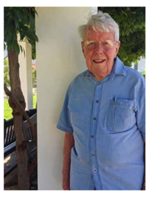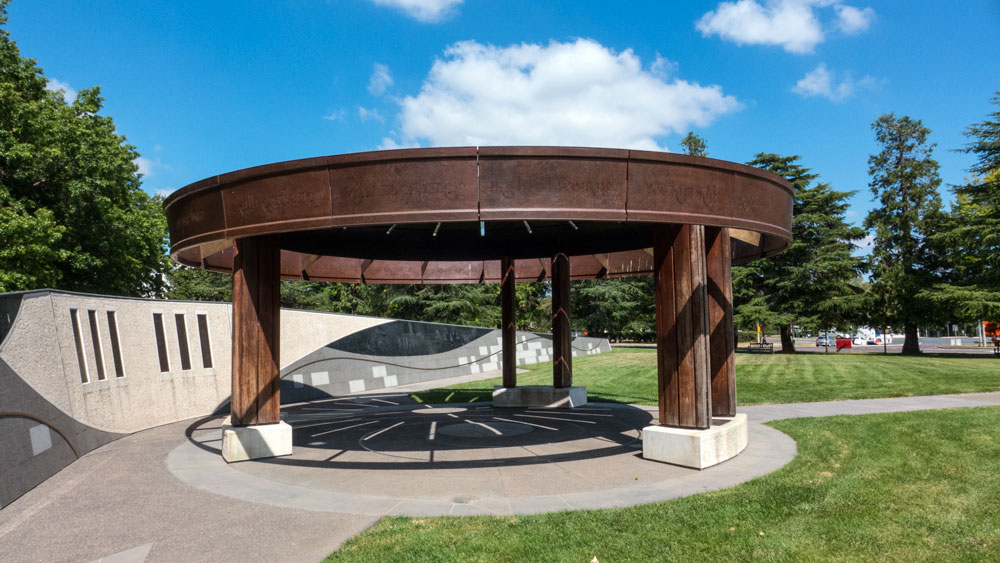Magna Carta Place, Canberra Parliamentary Triangle, one of John Gray’s landscape design projects, photo The Riot Act
Tribute by Max Bourke, AM
Recently Dr John Gray passed away and all those interested in not only the landscape, but specifically the ‘treescape’ of Canberra, and elsewhere, should pause to thank him.
John was in many ways a direct link to that great chain of Charles Weston and Lindsay Pryor, ‘founding fathers’ when it comes to Canberra landscapes in general, as well as the aesthetic and environmental benefits that we get from great tree planting programs.
John once said to me, ‘We can’t afford to ignore the way in which the planet works. We cannot afford to ignore its natural ecosystems and the resources we’re benefitting from.’
He lived a life trying to achieve that.
With a cadetship from the NSW Forestry Commission in 1948, he studied at Sydney University then the Australian Forestry School in Yarralumla before taking up positions with the Commission in their Queanbeyan and Bateman’s Bay offices. Returning to Canberra with the Timber Bureau he ran their seed laboratory at a time of great demand, especially from overseas, for eucalypt seeds.

Following, in some respects, Professor Lindsay Pryor’s path, he joined the Parks and Gardens Section of the Department of the Interior and the National Capital Development Commission (NCDC). He was excited by the prospect of working on the landscaping for the future Lake Burley Griffin, and being the person to deliver the design concepts of Richard Clough. John planted many of the significant areas of the National Capital during this time especially, in the Parliamentary Triangle as well as new suburbs in Woden and Belconnen.
This led him to ‘upscale’ his design credentials. He and his wife Pixie went to the University of California, Berkeley, where he studied under the famous US landscape architect Garret Eckbo, author of the seminal work, Landscape for Living (1950).
Returning to Australia, he taught at the Canberra College of Advanced Education then joined the NCDC, again to work beside Richard Clough, whom he succeeded. He was always a major contributor to professional bodies in his field, serving as National President of the Royal Australian Institute of Parks and Recreation as well as in the Australian Institute of Landscape Architects. He left the NCDC when it closed down in 1988.
John’s long interest in garden and landscape history led him to undertake a PhD, completed in 1999, titled ‘Thomas Charles George Weston (1866-1935) – a critical review of his contribution to the establishment of the landscape foundation of Australia’s national capital’ (available online at the University of Canberra site.) After ‘retiring’ from the public sector he undertook a number of landscape design projects at Old Parliament House, the Australian War Memorial and Magna Carta Place.
He was always a gentle and reflective man, who could be a great companion in a grove of trees. Hopefully, another ‘legacy’ of John’s will come to fruition in a biography of Charles Weston, written by Robert Macklin with John Gray, which we are working toward publishing in 2024!
Vale John Gray.
The ACT Heritage Library also holds a collection of John’s work and research papers, which are available for study on site. https://www.library.act.gov.au/find/history/search/Manuscript_Collections/john_gray_research_and_consultancy_papers
Another product of John’s research, a booklet titled Roses, Tennis & Democracy – The story of the Old Parliament House Gardens, Canberra is available online at https://www.nca.gov.au/sites/default/files/Roses%20Tennis%20and%20Democracy.pdf
There is an oral history recording of John Gray interviewed by Margaret Park held at the Australian National Library and this can also be accessed online. https://catalogue.nla.gov.au/catalog/5598847
See also ‘John Gray – a life in trees and parks’ by Max Bourke AGH Vol. 27 No. 4 April 2016


